In the wake of yet another new film (released in July) and much scuttlebutt regarding a new TV show reboot, this movie remains the cleanest, clearest reiteration of the ethos of the original show to date. Creator Gene Roddenberry himself may have wanted the show and films to reflect the more sober traits of his original conception – de facto egalitarianism, benevolent imperialism, the headiness of exploration itself, as exemplified in Star Trek: The Motion Picture (1979) and the Next Generation series (1987-1994, plus films) and other recombinations of the franchise through the decades, but what he got, and what fans carry deep in their hearts for the entire Star Trek universe, is much closer to what’s captured in the energy, interpersonal dynamics, and downright fun of Star Trek II: The Wrath of Khan.
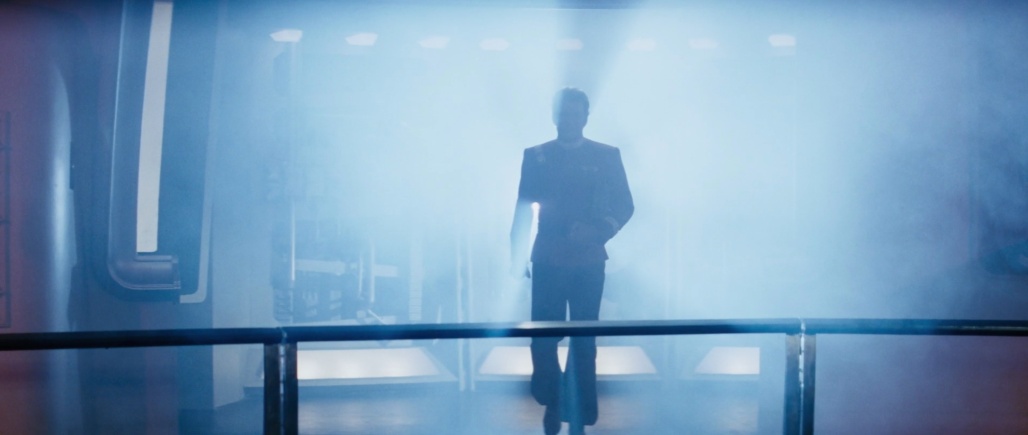
When the movie was first released, it was without its numerical signifier. The fact makes me think the animating principle behind its making wasn’t too far from the reboot mentality we see so rampant now, including with its own namesake. So divergent is the second film from the first in terms of tone, look, and character, you can practically hear the movie saying “scratch that, how bout this.” But the way the movie was cooked up doesn’t sound like a formula for greatness – in fact, it smells a lot like low self-esteem. Hire a guy, director Nicholas Meyer (a relative newbie, versus the venerable old-school hero-hire of The Motion Picture‘s Robert Wise), who had no previous love for the TV show, marry him to a budget that was a fraction of its predecessor’s, then cobble bits and pieces from five different commissioned scripts into a makeshift spine for a story – an estranged son here, a world-building bomb there, the death of a friend somewhere in the mix. Sounds like a recipe for something lumpy and slapdash.
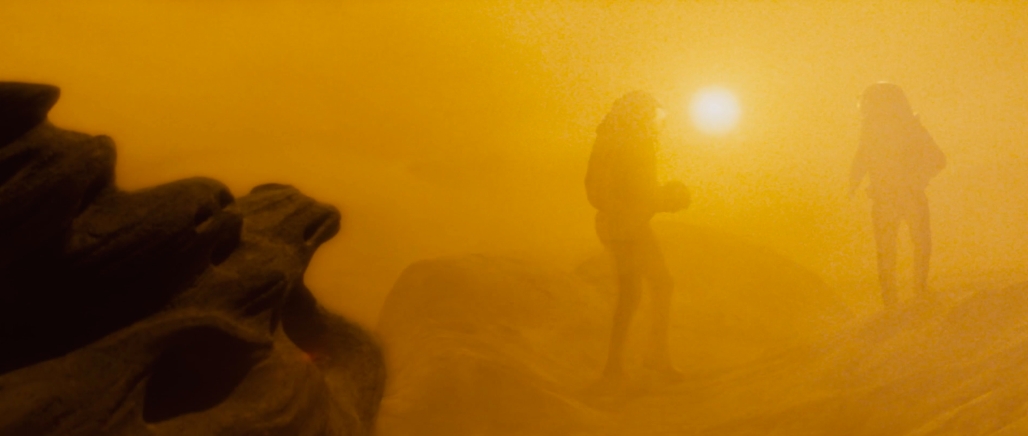
But Meyer was smart – he hadn’t seen many episodes, so he hunkered down in a Paramount screening room and watched the whole stack of ’em, and came away with three fundamental framing insights. His first takeaway is right there in the first image of the movie: he divined that the first thing springing to mind when fans think of the show, almost at a subconscious level, is Spock’s ears – so he parked one of them front and center in the first shot, as Spock studies a screen on the bridge of the Enterprise. Meyer’s sense that fans of the show had a strong emotional connection to the one character who shows zero emotions became a principle that guides the movie’s emotional through-line right into the end credits. The second insight was the show’s DNA-deep connection to both pirate and submarine fare, that the heart of the premise was “gunboat diplomacy”. So he and writers Harve Bennett (who also produced the movie) and Jack Soward crafted the story into a Sea Hawk or Captain Blood style adventure, with its central figure, Kirk, a 23rd century Horatio Hornblower. The movie eventually focuses on two ships at war that are technologically crippled, banking slow in deep space, and wrecking each other’s broadsides like futuristic textbook plates at West Point, Mars Campus. All of which ultimately strips away the usual reliance (pun partially intended) on technology to save the day and pushes the driving force of the drama instead toward a game of sheer wits. Federation tech school jargon that became endemic in later iterations of the TV show can sometimes disengage the adventure. Here, without it, it’s just this guy in this disabled ship against this guy in this disabled ship, and it’s beautifully simple.
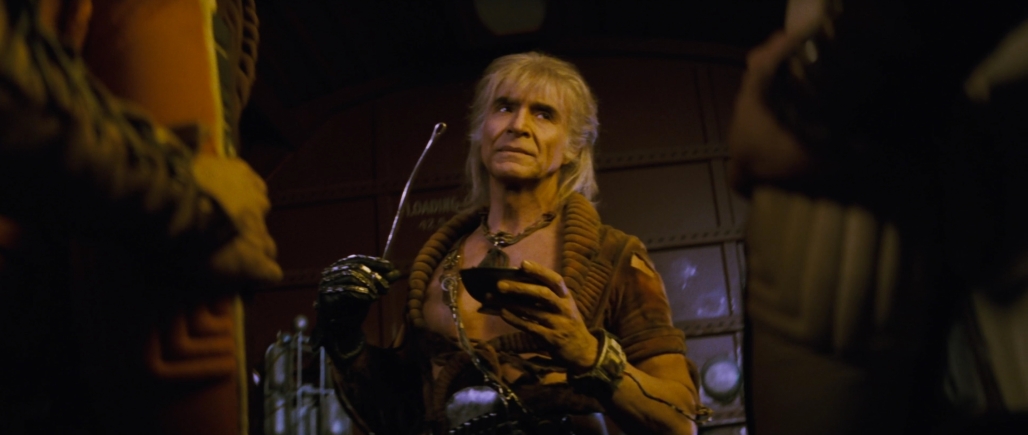
But the most significant takeaway is the true key to the success of the movie: there’s a central triangle that informs everything else about the show, one formed by the personalities of Kirk, Spock, and McCoy. Solving a problem supplies these three characters with something to do, but the meat of the movie is really the comfortable camaraderie among them. You know right away they have long backstories together, and that they love each other, a sense you get even if you haven’t seen any of the old episodes. This dynamic puts it in fine company with another favorite, Rio Bravo, Howard Hawks’ movie that famously feels less about the plot than it does about a group of characters, or more accurately a group of actors, getting to hang out together. The loping, genial vibe of that entire movie is built to keep perfect time with John Wayne’s languid gait and drawl. Likewise, Wrath of Khan jettisons the stultified, ponderous, 2001-lite tone of the original movie, and aligns itself more with the rhythms of the key central unit, that at-once meditating, opinionated, action-ready triangle. The new dynamic pulls the fun and friendship angle from the ’60s show and drops it into a movie that is itself a continuation of a story from the ’60s show – it allows the deepest fondness for the past to be the sturdiest foundation of what is to come in the film. The ethical debate after the three view the Genesis video is the heart of the movie in terms of the old show – the fact that they can be friends and still have these angry moments – that they care enough to argue about it at all. In the three years of that original five-year mission that we got to see, that kind of bond was forged to the point it can never be realistically questioned. It just is.
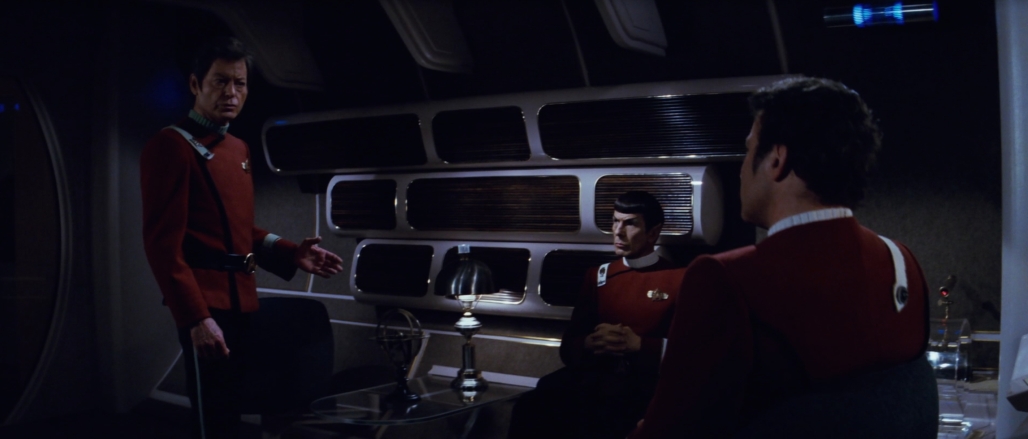
The movie’s major motif is death/rebirth, “life from lifelessness”, youth/old age – essentially hanging a lantern on the hairpieces. The innately downbeat essence of it all works so well within the otherwise action-anchored frame thanks to how fluidly and humorously those themes are set up in the first part of the movie. The Kobayashi Maru sequence is the perfect short film to give us everything we need to know about what the movie will “say” and how it will say it: failure on the bridge, the simulation of high-profile death, a test of the “no-win situation” once circumvented by the same man who now administers the test, the subtle touch of Kirk’s possession of a book that begins “It was the best of times, it was the worst of times.” Then in the next few scenes we learn it is, of all days, Kirk’s birthday, that he’s been promoted out of his essential calling in life, that he’s feeling useless, that he’s surrounded by a crew that’s less than half his age, that he goes home to an apartment with no mementos of a family life, but is rife with antiques – things harkening back to the past, things which he’s lost or never had – that he’s only on the ship that day as a sort of hood ornament on the showroom’s classiest car, and, of course, that he and the crew soon become embroiled in the rescue of a machine that literally makes newness from death. The movie is so single-minded in its rollout of these mortality-related themes in the first half hour that the rest of the plot is infused and illuminated in ways that help it transcend mere adventure.
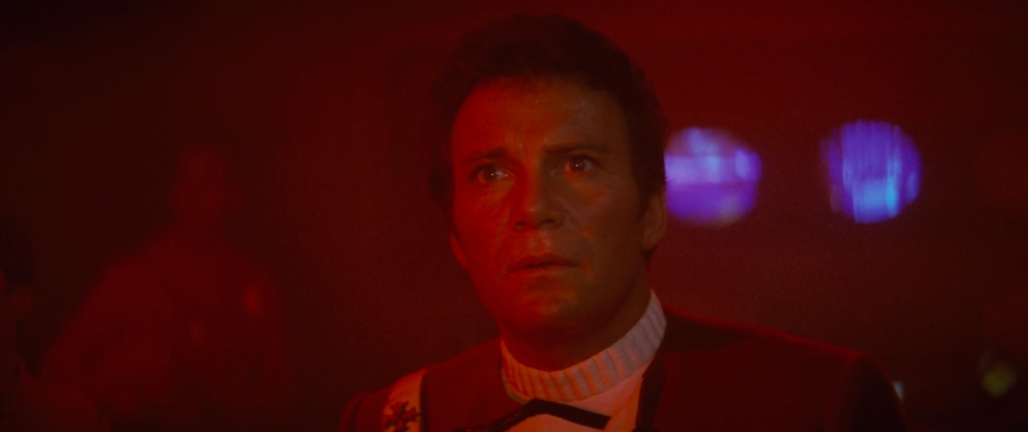
Then, at last, these thematic elements get fire-tested when the plot proper kicks in and Kirk gets a rude visit by the loose cannon result of his own mistakes, a situation ingeniously unspooling out of the final moments of the original series episode Space Seed. It was fifteen years prior, and the Enterprise had stumbled on a derelict basket in the reeds, the Botany Bay, holding the sleep-chambered remnants of a genetically-enhanced breed of human from the 1990s, über-humans, led by a hulking dynamo of wily charisma, Khan, played by… a hulking dynamo of wily charisma, Ricardo Montalban. Once awakened, so commences Khan’s takeover of the ship, the ensuing battle of brawn and brain, and the eventual banishing of Khan and his followers onto a remote planet to fend for themselves. We see from the film’s re-introduction of that hearty band that the titular wrath of Khan is fairly well justified: the planet has turned on its axis, has become an uninhabitable wasteland, and many have died, including his beloved wife. The Khan that results, and the vengeance he swears on Kirk, is indeed what has “sprung from the seed” Kirk planted those years ago. Khan feels forsaken, abandoned by Kirk, and fully justified in meting out his fury – visceral stakes that play parallel to the emotional stakes infused in the revelation of a son Kirk has also effectively abandoned. Khan swipes a Federation ship, the Reliant, and confronts Kirk in his own living room, the bridge of the Enterprise. When Kirk rises into frame, seeing the figure on the screen, we see the look on his face and we can practically watch the entirety of Space Seed play across his eyes in fast forward. He’s positively wobbly-kneed. Meyer, et al, have allowed Kirk, maybe truly for the first time, to be, in these initial Khan scenes, more than a little unsure of himself. On the show, we rarely had doubt that he knew his way out of any situation. Here, his character is shown to be more last-minute and desperate in moments of crisis than ever before. There’s a keen trace of the previous summer’s Indiana Jones in Kirk’s expression when he turns from the first encounter with Khan and says he “just got caught with his britches down.” I wonder if some of that film’s embracing of a character “just making it up as he’s going” didn’t rub off on the writers of this film. So it’s the head-to-head of two alpha figures, one a juggernaut amalgam of Ahab, Lear, and Lucifer, and near-one-dimensionally bent on revenge, and one a hero shot through with age-driven self-doubt. It’s a thrill to watch Kirk stumble. A movie with a nemesis strong enough that, for even five minutes, the audience is thrown into doubt about the hero’s ability to win, is a great feat rarely seen in most modern action movies.
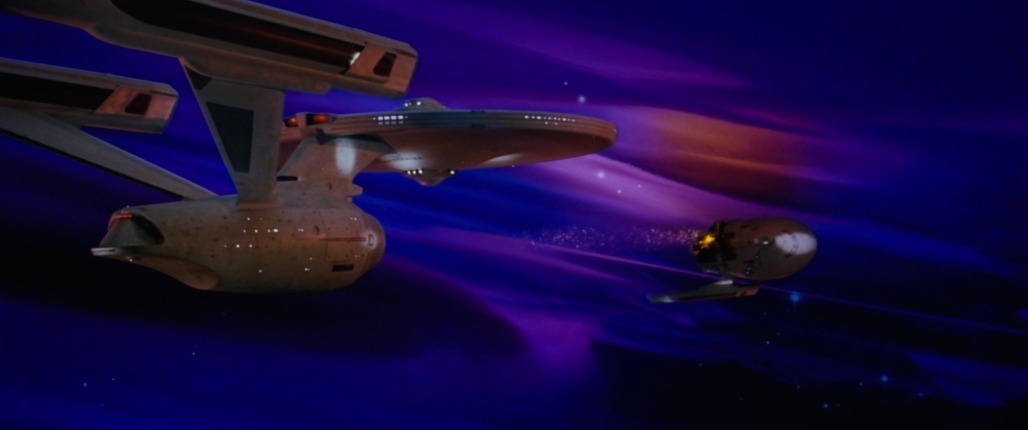
One of the things that keeps the movie lovable is its undeniable cheese factor, most colorfully embodied in the dueling hamminess of Shatner and Montalban. Shatner is restrained for the most part – Meyer admits he went for more takes than usual with him, not because Shatner wasn’t being acceptably Kirk, but because he knew he’d get a more real performance from Shatner only after he got bored with the lines. Meanwhile, Meyer allows Montalban to fully embrace the cheese that is the beating heart of Khan. There are many great moments of Khan seething out his lines, a villainous whisper, but even those moments are infused with a bigness that cannot be contained. Montalban’s performance as Khan in the Space Seed episode is almost at times too over-the-top to watch – it’s not a bad performance, just one that wants to spill outside confines of a mere TV production. These sorts of broad strokes will always fit better in a movie. But his performance, above and beyond anything else in the movie, is what ultimately makes it as fun as it is on repeat viewings. Shatner’s performance is tamped down in The Motion Picture as well, but so is that entire movie – there’s no real sense of fun, Wise bringing his best Andromeda Strain game face to the proceedings, stealing it almost entirely away from the adventure category. But in Khan, Kirk is tamped down in a way that allows there to be balance against the unstoppable energy of Montalban’s performance. The biggest exception is perhaps the most famous pop-culture moment from the movie: Kirk shouting “Khaaan!!” It’s become a cultural catch-all for any argument brandished against Shatner’s acting. But allow me to posit a defense for this notably ridiculed moment: it’s not Shatner going over the top, it’s Kirk. He, in that moment, already knows he’s going to be rescued, he’s already set it up with Spock to beam them out in two hours. But he has to convince Khan that he actually believes he’s doomed along with the rest inside the center of a dead planet, so Kirk goes over the top to communicate with Khan at the only pitch he knows Khan will hear – big. You can’t blame Kirk if he goes over the top: he’s not an actor, Jim, he’s a starship admiral. In any case, there’s probably a justification at the ready for any “blemish” called out from a fan’s beloved movie. I’m willing to enjoy moments like this in any of the original crew films (yes, even Star Trek V!), not for the budget-forced or ego-excessive flaws they’re perceived as, but for the fun they’re supposed to inspire, hamminess and all.
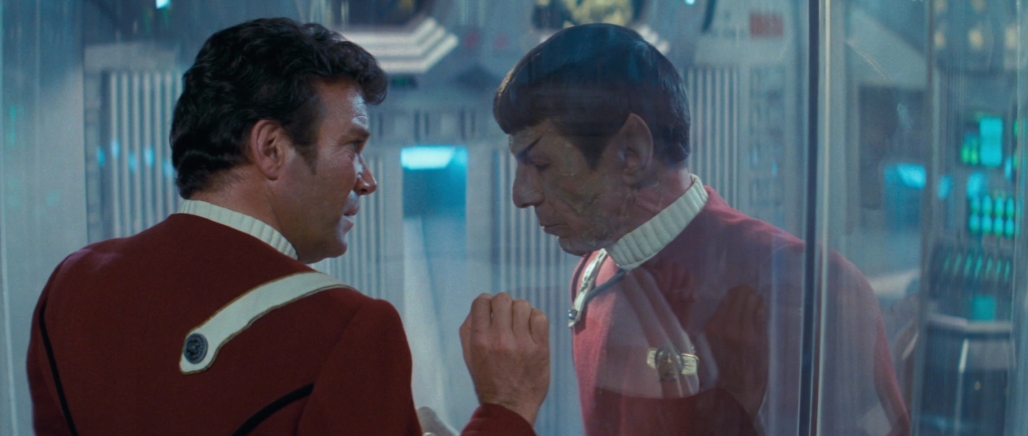
By way of conclusion, a bit of perhaps sentimental testimony: I was eleven, sitting in the movie theater, watching these characters that’d become my friends in the old TV reruns, now giant, now loud, now in real, exploding, one hundred percent danger instead of just TV danger. I’m still stunned when Spock takes that short moment to let his salvation plan get 3D in his brain, then leaps up to make it happen. I want to tell him to stop! – but somehow I know this is how it’s got to be. And the palm-to-palm farewell. I admit I still get choked up. Today, it’s not just that a friend is gone; I know full well there’sStar Trek III and beyond. Today, it’s that my age makes me relate less to Spock’s singular act of sacrifice, and more the deep-down-in-the-screenplay meditation on the pangs of getting older, and the changes that hit that don’t have automatically built-in sequels. What moves me most now is watching Shatner’s humbled Kirk, God bless ‘im, pondering his own regrets, coming face to face with old mistakes, and embracing the opportunities that come so rarely to renew an old lost love. For me, and apparently many others, the movie, for all its audience-friendly action and its fairly simple black hat/white hat set-ups, is deeply philosophical, mature and completely satisfying.
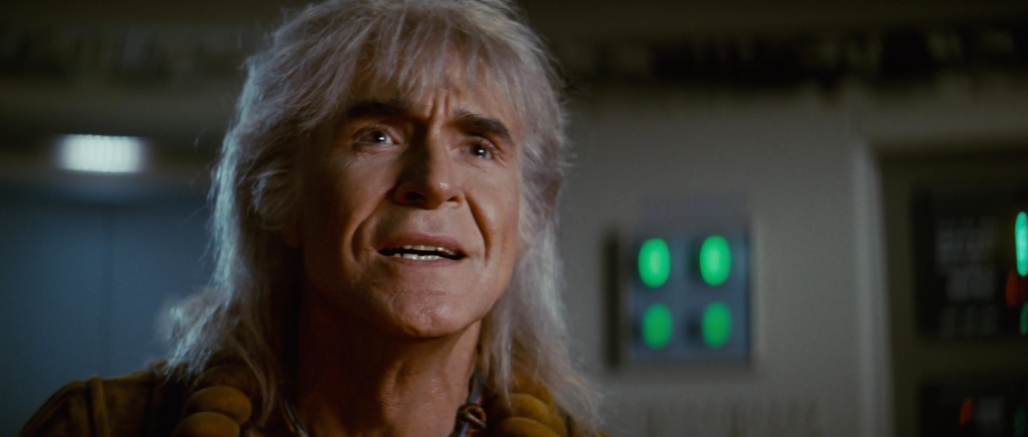
No comments:
Post a Comment